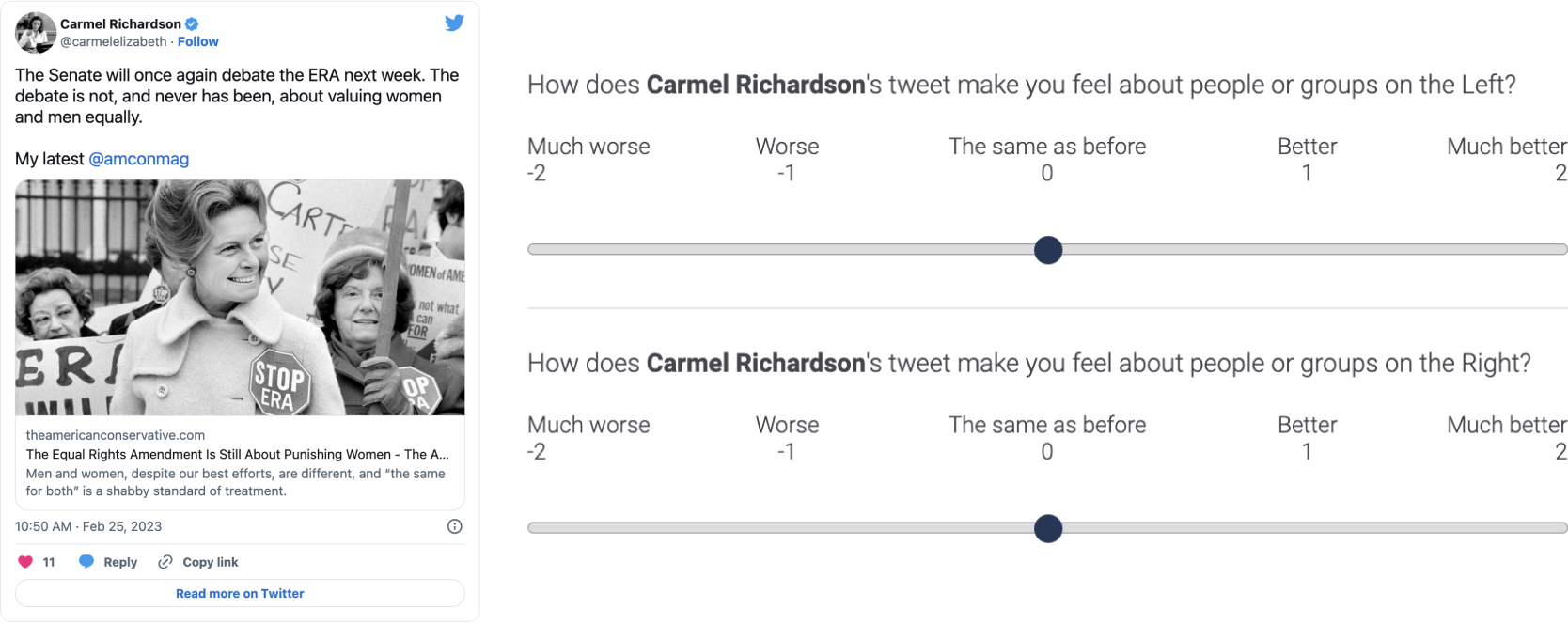Surveys
A review of survey questions used to measure "division" or "polarization".
Our aim with this work is to improve our capacity to develop systems that satisfy the bridging goal: an increase mutual understanding and trust across divides, creating space for productive conflict, deliberation, or cooperation. Here we list survey instruments that have been used in related literature.
Context
One of the main ways of quantifying aspects of human relationships (such as division or polarization) is to simply ask people questions.
The scope of questions can vary — we can ask people (1) about themselves, or (2) about an external focus, such as an item of content. Examples of the second type of question are illustrated below, taken from this study by Milli et al. (2023).

Fields such as measurement theory and psychometrics have developed methods for designing better questions, and evaluating whether a given set of questions has good properties like actually measuring what it was intended to measure (validity), and giving similar answers in similar situations (reliability). We intend to summarize what is known about the validity and reliability of listed survey instruments in the table below, though this is a work in progress.
A consistent set of questions is sometimes called a survey instrument.
Caution
While the survey instruments below are presented as possible measures of this “bridging goal”, evidence for their validity is limited, and it is not clear how robust they are to Goodhart’s Law. For this reason, none of the survey instruments on this page should be used as optimization targets in an attention-allocator (such as a social media platform) without considerable care to monitor and avoid unintended consequences.
Table of Survey Instruments
To toggle fullscreen mode, use your Esc key or the purple button in the table.
|
Instrument
|
Target
|
Scope
|
Items (wording can vary)
|
References
|
|---|---|---|---|---|
| feeling thermometer | partisan animosity | person |
We would like to get your feelings toward both Party A and Party B. We would like you to rate them using something we call the feeling thermometer. Ratings between 50 degrees and 100 degrees mean that you feel favorable and warm toward them. Ratings between 0 degrees and 50 degrees mean that you don't feel favorable toward them and that you don't care too much for them. You would rate them at the 50 degree mark if you don't feel particularly warm or cold toward them.
Both items responded to on a 101-point scale from "Very cold or unfavorable feeling" to "No feeling at all" to "Very warm or favorable feeling". | |
| dictator game | partisan animosity | person |
You have been anonymously and randomly matched with another participant who identifies as an Outpartisan. You have been given 50 cents. You will now decide how to split these 50 cents between yourself and the Outpartisan participant. You can give any amount between 0 cents and 50 cents to the other participant. The other participant cannot affect the outcome you choose. For example:
| |
| (untitled) | support for undemocratic practices | person |
Please indicate how much you disagree or agree with each of the following statements.
All items responded to on a 101-point scale from "Strongly disagree" to "Strongly agree". | |
| (untitled) | support for partisan violence | person |
Please answer the following questions.
| |
| candidate choice experiment | support for undemocratic candidates | person |
For the next series of questions, please imagine an Inpartisan candidate runs for office against an Outpartisan candidate.”
All items responded to on a 101-point scale from "Definitely vote for the Outparty candidate" to "Definitely vote for the Inparty candidate". | |
| (untitled) | biased evaluation of politicized facts | person |
In this task, we will ask you to give us your opinion about various claims. The claims are statements that may be true or may be false. The truth or falsity of the statements has been determined by real-world sources. What is the likelihood that the following statements are true? Please choose a point that best describes your view on the below scale that goes from 0% (certainly false) to 100% (certainly true). Items asked of Republicans:
Items asked of Democrats:
All items responded to on a 101-point scale from "0% certainly false" to "100% certainly true". | |
| (untitled) | opposition to bipartisan cooperation | person |
Both items responded to on a 101-point scale from "Not at all" to "A great deal". | |
| (untitled) | social distrust | person |
| |
| (untitled) | social distance | person |
Both items responded to on a 101-point scale from "Not comfortable at all" to "Extremely comfortable". |